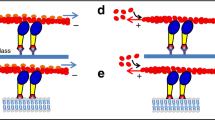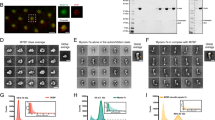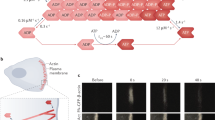Abstract
Actin and myosin are major components of the cell cytoskeleton, with structural and regulatory functions that affect many essential cellular processes. Although they were traditionally thought to function only in the cytoplasm, it is now well accepted that actin and multiple myosins are found in the nucleus. Increasing evidence on their functional roles has highlighted the importance of these proteins in the nuclear compartment.
This is a preview of subscription content, access via your institution
Access options
Subscribe to this journal
Receive 12 print issues and online access
$209.00 per year
only $17.42 per issue
Buy this article
- Purchase on Springer Link
- Instant access to full article PDF
Prices may be subject to local taxes which are calculated during checkout



Similar content being viewed by others
Change history
29 April 2015
In the version of this Review originally published the authors inadvertently omitted a key reference. This has now been added to the caption of Fig. 3 in the online version: 'The actin-binding protein WASP has been discovered in the nucleus and modulates transcription independently or with the ARP2/3 complex97.' 97. Taylor, M. D. et al. Nuclear role of WASp in the pathogenesis of dysregulated TH1 immunity in human Wiskott-Aldrich syndrome. Sci. Transl. Med. 2, 37ra44 (2010).
14 May 2015
In the version of this Review originally published reference 34 should have appeared in the caption of Fig. 3: 'The actin-binding protein WASP has been discovered in the nucleus and modulates transcription independently or with the ARP2/3 complex34,97.' This has been corrected in the online versions of the Review.
References
Sellers, J. R. Fifty years of contractility research post sliding filament hypothesis. J. Muscle Res. Cell Motil. 25, 475–482 (2004).
Schmidt, A. & Hall, M. N. Signaling to the actin cytoskeleton. Annu. Rev. Cell Dev. Biol. 14, 305–338 (1998).
Pollard, T. D. & Korn, E. D. Acanthamoeba myosin. I. Isolation from Acanthamoeba castellanii of an enzyme similar to muscle myosin. J. Biol. Chem. 248, 4682–4690 (1973).
Nowak, G. et al. Evidence for the presence of myosin I in the nucleus. J. Biol. Chem. 272, 17176–17181 (1997).
Pestic-Dragovich, L. et al. A myosin I isoform in the nucleus. Science 290, 337–341 (2000).
Pederson T. As functional nuclear actin comes into view, is it globular, filamentous, or both? J. Cell Biol. 180, 1061–1064 (2008).
Pollard, T. D., Blanchoin, L. & Mullins, R. D. Molecular mechanisms controlling actin filament dynamics in nonmuscle cells. Annu. Rev. Biophys. Biomol. Struct. 29, 545–576 (2000).
Gonsior, S. M. et al. Conformational difference between nuclear and cytoplasmic actin as detected by a monoclonal antibody. J. Cell Sci. 112, 797–809 (1999).
Schoenenberger, C. A. et al. Conformation-specific antibodies reveal distinct actin structures in the nucleus and the cytoplasm. J. Struct. Biol. 152, 157–168 (2005).
Kandasamy, M. K., McKinney, E. C. & Meagher, R. B. Differential sublocalization of actin variants within the nucleus. Cytoskeleton (Hoboken) 67, 729–743 (2010).
McDonald, D., Carrero, G., Andrin, C., de Vries, G. & Hendzel, M. J. Nucleoplasmic β-actin exists in a dynamic equilibrium between low-mobility polymeric species and rapidly diffusing populations. J. Cell Biol. 172, 541–552 (2006).
Fukui Y, Katsumaru, H. Dynamics of nuclear actin bundle induction by dimethyl sulfoxide and factors affecting its development. J. Cell Biol. 84, 131–140 (1980).
Nishida, E. et al. Cofilin is a component of intranuclear and cytoplasmic actin rods induced in cultured cells. Proc. Natl Acad. Sci. USA 84, 5262–5266 (1987).
Pendleton, A., Pope, B., Weeds, A. & Koffer, A. Latrunculin B or ATP depletion induces cofilin-dependent translocation of actin into nuclei of mast cells. J. Biol. Chem. 278, 14394–14400 (2003).
Domazetovska, A. et al. Intranuclear rod myopathy: molecular pathogenesis and mechanisms of weakness. Ann. Neurol. 62, 597–608 (2007).
Taylor, M. P., Koyuncu, O. O. & Enquist, L. W. Subversion of the actin cytoskeleton during viral infection. Nat. Rev. Microbiol. 9, 427–439 (2011).
Goley, E. D. et al. Dynamic nuclear actin assembly by Arp2/3 complex and a baculovirus WASP-like protein. Science 314, 464–467 (2006).
Feierbach, B., Piccinotti, S., Bisher, M., Denk, W. & Enquist, L. W. α-herpesvirus infection induces the formation of nuclear actin filaments. PLoS Pathog. 2, e85 (2006).
Chang, L. et al. Herpesviral replication compartments move and coalesce at nuclear speckles to enhance export of viral late mRNA. Proc. Natl Acad. Sci. USA http://dx.doi.org/10.1073/pnas.1103411108 (2011).
Hofmann, W. A. et al. SUMOylation of nuclear actin. J. Cell Biol. 186, 193–200 (2009).
Abe, A., Saeki, K., Yasunaga, T. & Wakabayashi, T. Acetylation at the N-terminus of actin strengthens weak interaction between actin and myosin. Biochem. Biophys. Res. Commun. 268, 14–19 (2000).
Karakozova, M. et al. Arginylation of β-actin regulates actin cytoskeleton and cell motility. Science 313, 192–196 (2006).
Wang, J. et al. Stable and controllable RNA interference: Investigating the physiological function of glutathionylated actin. Proc. Natl Acad. Sci. USA 100, 5103–5106 (2003).
Pekiner, C. et al. Glycation of brain actin in experimental diabetes. J. Neurochem. 61, 436–442 (1993).
Aslan, M. et al. Nitric oxide-dependent generation of reactive species in sickle cell disease. Actin tyrosine induces defective cytoskeletal polymerization. J. Biol. Chem. 278, 4194–4204 (2003).
Thom, S. R., Bhopale, V. M., Mancini, D. J. & Milovanova, T. N. Actin S-nitrosylation inhibits neutrophil β2 integrin function. J. Biol. Chem. 283, 10822–10834 (2008).
Gettemans, J. et al. Nuclear actin-binding proteins as modulators of gene transcription. Traffic 6, 847–857 (2005).
Iida, K., Matsumoto, S. & Yahara, I. The KKRKK sequence is involved in heat shock-induced nuclear translocation of the 18-kDa actin-binding protein, cofilin. Cell Struct. Funct. 17, 39–46 (1992).
Stuven, T., Hartmann, E. & Gorlich, D. Exportin 6: a novel nuclear export receptor that is specific for profilin–actin complexes. EMBO J. 22, 5928–5940 (2003).
Hubert, T., Van Impe, K., Vandekerckhove, J. & Gettemans, J. The F-actin filament capping protein CapG is a bona fide nucleolar protein. Biochem. Biophys. Res. Commun. 377, 699–704 (2008).
Ambrosino, C. et al. Identification of a hormone-regulated dynamic nuclear actin network associated with estrogen receptor α in human breast cancer cell nuclei. Mol. Cell Proteomics 9, 1352–1367 (2010).
Huang, S. M., Huang, C. J., Wang, W. M., Kang, J. C. & Hsu, W. C. The enhancement of nuclear receptor transcriptional activation by a mouse actin-binding protein, α actinin 2. J. Mol. Endocrinol. 32, 481–496 (2004).
Yoo, Y., Wu, X. & Guan, J. L. A novel role of the actin-nucleating Arp2/3 complex in the regulation of RNA polymerase II-dependent transcription. J. Biol. Chem. 282, 7616–7623 (2007).
Wu, X. et al. Regulation of RNA-polymerase-II-dependent transcription by N-WASP and its nuclear-binding partners. Nat. Cell Biol. 8, 756–763 (2006).
Zhao, K. et al. Rapid and phosphoinositol-dependent binding of the SWI/SNF-like BAF complex to chromatin after T lymphocyte receptor signaling. Cell 95, 625–636 (1998).
Kukalev, A., Nord, Y., Palmberg, C., Bergman, T. & Percipalle, P. Actin and hnRNP U cooperate for productive transcription by RNA polymerase II. Nat. Struct. Mol. Biol. 12, 238–244 (2005).
Obrdlik, A. et al. The histone acetyltransferase PCAF associates with actin and hnRNP U for RNA polymerase II transcription. Mol. Cell Biol. 28, 6342–6357 (2008).
Qi, T. et al. G-actin participates in RNA polymerase II-dependent transcription elongation by recruiting positive transcription elongation factor b (P-TEFb). J. Biol. Chem. 286, 15171–15181 (2011).
Blessing, C. A., Ugrinova, G. T. & Goodson, H. V. Actin and ARPs: action in the nucleus. Trends Cell Biol. 14, 435–442 (2004).
Grummt, I. Actin and myosin as transcription factors. Curr. Opin. Genet. Dev. 16, 191–196 (2006).
Hu, P., Wu, S. & Hernandez, N. A role for β-actin in RNA polymerase III transcription. Genes Dev. 18, 3010–3015 (2004).
Hofmann, W. A. et al. Actin is part of pre-initiation complexes and is necessary for transcription by RNA polymerase II. Nat. Cell Biol. 6, 1094–1101 (2004).
Percipalle, P. et al. Actin bound to the heterogeneous nuclear ribonucleoprotein hrp36 is associated with Balbiani ring mRNA from the gene to polysomes. J. Cell Biol. 153, 229–236 (2001).
Percipalle, P. et al. Nuclear actin is associated with a specific subset of hnRNP A/B-type proteins. Nucleic Acids Res. 30, 1725–1734 (2002).
Percipalle, P. et al. An actin–ribonucleoprotein interaction is involved in transcription by RNA polymerase II. Proc. Natl Acad. Sci. USA 100, 6475–6480 (2003).
Sjolinder, M. et al. The growing pre-mRNA recruits actin and chromatin-modifying factors to transcriptionally active genes. Genes Dev. 19, 1871–1884 (2005).
Jaalouk, D. E. & Lammerding, J. Mechanotransduction gone awry. Nat. Rev. Mol. Cell Biol. 10, 63–73 (2009).
Haller, K., Rambaldi, I., Daniels, E. & Featherstone, M. Subcellular localization of multiple PREP2 isoforms is regulated by actin, tubulin and nuclear export. J. Biol. Chem. 279, 49384–49394 (2004).
Favot, L., Hall, S. M., Haworth, S. G. & Kemp, P. R. Cytoplasmic YY1 is associated with increased smooth muscle-specific gene expression: implications for neonatal pulmonary hypertension. Am. J. Pathol. 167, 1497–1509 (2005).
Vartiainen, M. K., Guettler, S., Larijani, B. & Treisman, R. Nuclear actin regulates dynamic subcellular localization and activity of the SRF cofactor MAL. Science 316, 1749–1752 (2007).
Dupont, S. et al. Role of YAP/TAZ in mechanotransduction. Nature 474, 179–183 (2011).
Luxton, G. W., Gomes, E. R., Folker, E. S., Vintinner, E. & Gundersen, G. G. Linear arrays of nuclear envelope proteins harness retrograde actin flow for nuclear movement. Science 329, 956–959 (2010).
Razafsky, D. & Hodzic, D. Bringing KASH under the SUN: the many faces of nucleo-cytoskeletal connections. J. Cell Biol. 186, 461–472 (2009).
Shumaker, D. K., Kuczmarski, E. R. & Goldman, R. D. The nucleoskeleton: lamins and actin are major players in essential nuclear functions. Curr. Opin. Cell Biol. 15, 358–366 (2003).
Holaska, J. M. & Wilson, K. L. An emerin “proteome”: purification of distinct emerin-containing complexes from HeLa cells suggests molecular basis for diverse roles including gene regulation, mRNA splicing, signaling, mechanosensing and nuclear architecture. Biochemistry 46, 8897–8908 (2007).
Coluccio, L. M. in Proteins And Cell Regulation Vol. 7 (ed. Coluccio, L. M.) 95–124 (Springer Netherlands, 2008).
Hofmann, W. A., Johnson, T., Klapczynski, M., Fan, J. L. & de Lanerolle, P. From transcription to transport: emerging roles for nuclear myosin I. Biochem. Cell Biol. 84, 418–426 (2006).
Hokanson, D. E. & Ostap, E. M. Myo1c binds tightly and specifically to phosphatidylinositol-4,5-bisphosphate and inositol-1,4,5-trisphosphate. Proc. Natl Acad. Sci USA 103, 3118–3123 (2006).
Fomproix, N. & Percipalle, P. An actin-myosin complex on actively transcribing genes. Exp. Cell Res. 294, 140–148 (2004).
Ye, J., Zhao, J., Hoffmann-Rohrer, U. & Grummt, I. Nuclear myosin I acts in concert with polymeric actin to drive RNA polymerase I transcription. Genes Dev. 22, 322–330 (2008).
Philimonenko, V. V. et al. Nuclear actin and myosin I are required for RNA polymerase I transcription. Nat. Cell Biol. 6, 1165–1172 (2004).
Hofmann, W. A. et al. Nuclear myosin I is necessary for the formation of the first phosphodiester bond during transcription initiation by RNA polymerase II. J. Cell Biochem. 99, 1001–1009 (2006).
Obrdlik, A. et al. Nuclear myosin 1 is in complex with mature rRNA transcripts and associates with the nuclear pore basket. FASEB J 24, 146–157 (2010).
Kysela, K. et al. Nuclear distribution of actin and myosin I depends on transcriptional activity of the cell. Histochem. Cell Biol. 124, 347–358 (2005).
Philimonenko, V. V., Janacek, J., Harata, M. & Hozak, P. Transcription-dependent rearrangements of actin and nuclear myosin I in the nucleolus. Histochem. Cell Biol. 134, 243–249 (2010).
Raska, I., Shaw, P. J. & Cmarko, D. Structure and function of the nucleolus in the spotlight. Curr. Opin. Cell Biol. 18, 325–334 (2006).
Spector, D. L. The dynamics of chromosome organization and gene regulation. Annu. Rev. Biochem. 72, 573–608 (2003).
Chuang, C. H. et al. Long-range directional movement of an interphase chromosome site. Curr. Biol. 16, 825–831 (2006).
Hu, Q. et al. Enhancing nuclear receptor-induced transcription requires nuclear motor and LSD1-dependent gene networking in interchromatin granules. Proc. Natl Acad. Sci. USA 105, 19199–19204 (2008).
Dundr, M. et al. Actin-dependent intranuclear repositioning of an active gene locus in vivo. J. Cell Biol. 179, 1095–1103 (2007).
Mehta, I. S., Amira, M., Harvey, A. J. & Bridger, J. M. Rapid chromosome territory relocation by nuclear motor activity in response to serum removal in primary human fibroblasts. Genome Biol. 11, R5 (2010).
Percipalle, P. et al. The chromatin remodelling complex WSTF–SNF2h interacts with nuclear myosin 1 and has a role in RNA polymerase I transcription. EMBO Rep. 7, 525–530 (2006).
Smukste, I., Bhalala, O., Persico, M. & Stockwell, B. R. Using small molecules to overcome drug resistance induced by a viral oncogene. Cancer Cell 9, 133–146 (2006).
Percipalle, P. & Farrants, A. K. Chromatin remodelling and transcription: be-WICHed by nuclear myosin 1. Curr. Opin. Cell Biol. 18, 267–274 (2006).
Rodgers, B. D. Insulin-like growth factor-I downregulates embryonic myosin heavy chain (eMyHC) in myoblast nuclei. Growth Horm. IGF Res. 15, 377–383 (2005).
Pranchevicius, M. C. et al. Myosin Va phosphorylated on Ser1650 is found in nuclear speckles and redistributes to nucleoli upon inhibition of transcription. Cell Motil. Cytoskeleton 65, 441–456 (2008).
Lindsay, A. J. & McCaffrey, M. W. Myosin Vb localises to nucleoli and associates with the RNA polymerase I transcription complex. Cell Motil. Cytoskeleton 66, 1057–1072 (2009).
Vreugde, S. et al. Nuclear myosin VI enhances RNA polymerase II-dependent transcription. Mol. Cell 23, 749–755 (2006).
Buss, F., Spudich, G. & Kendrick-Jones, J. Myosin VI: cellular functions and motor properties. Annu. Rev. Cell Dev. Biol. 20, 649–676 (2004).
Altman, D., Sweeney, H. L. & Spudich, J. A. The mechanism of myosin VI translocation and its load-induced anchoring. Cell 116, 737–749 (2004).
Cameron, R. S. et al. Myosin16b: The COOH-tail region directs localization to the nucleus and overexpression delays S-phase progression. Cell Motil. Cytoskeleton 64, 19–48 (2007).
Salamon, M. et al. Human MYO18B, a novel unconventional myosin heavy chain expressed in striated muscles moves into the myonuclei upon differentiation. J. Mol. Biol. 326, 137–149 (2003).
Ajima, R. et al. Deficiency of Myo18B in mice results in embryonic lethality with cardiac myofibrillar aberrations. Genes Cells 13, 987–999 (2008).
Ajima, R. et al. HOMER2 binds MYO18B and enhances its activity to suppress anchorage independent growth. Biochem. Biophys. Res. Commun. 356, 851–856 (2007).
Bleeker, F. E. et al. Mutational profiling of cancer candidate genes in glioblastoma, melanoma and pancreatic carcinoma reveals a snapshot of their genomic landscapes. Hum. Mutat. 30, E451–459 (2009).
Skarp, K. P. & Vartiainen, M. K. Actin on DNA—an ancient and dynamic relationship. Cytoskeleton (Hoboken) 67, 487–495 (2010).
Goodson, H. V. & Hawse, W. F. Molecular evolution of the actin family. J. Cell Sci. 115, 2619–2622 (2002).
Richards, T. A. & Cavalier-Smith, T. Myosin domain evolution and the primary divergence of eukaryotes. Nature 436, 1113–1118 (2005).
Hofmann, W. A., Richards, T. A. & de Lanerolle, P. Ancient animal ancestry for nuclear myosin. J. Cell Sci. 122, 636–643 (2009).
Rodrigues, M. A., Gomes, D. A., Andrade, V. A., Leite, M. F. & Nathanson, M. H. Insulin induces calcium signals in the nucleus of rat hepatocytes. Hepatology 48, 1621–1631 (2008).
Bootman, M. D., Fearnley, C., Smyrnias, I., MacDonald, F. & Roderick, H. L. An update on nuclear calcium signalling. J. Cell Sci. 122, 2337–2350 (2009).
Li, Q. & Sarna, S. K. Nuclear myosin II regulates the assembly of preinitiation complex for ICAM-1 gene transcription. Gastroenterology 137, 1051–1060.e3 (2009).
Mortier, E. et al. Nuclear speckles and nucleoli targeting by PIP2–PDZ domain interactions. EMBO J. 24, 2556–2565 (2005).
Boronenkov, I. V., Loijens, J. C., Umeda, M. & Anderson, R. A. Phosphoinositide signaling pathways in nuclei are associated with nuclear speckles containing pre-mRNA processing factors. Mol. Biol. Cell 9, 3547–3560 (1998).
Osborne, S. L., Thomas, C. L., Gschmeissner, S. & Schiavo, G. Nuclear PtdIns(4,5)P2 assembles in a mitotically regulated particle involved in pre-mRNA splicing. J. Cell Sci. 114, 2501–2511 (2001).
Jung E. J., Liu, G., Zhou, W., Chen, X. Myosin VI is a mediator of the p53-dependent cell survival pathway. Mol. Cell Biol. 26, 2175–2186 (2006).
Taylor M. D. et al. Nuclear role of WASp in the pathogenesis of dysregulated TH1 immunity in human Wiskott-Aldrich syndrome. Sci. Transl. Med. 2, 37ra44 (2010).10.1126/scitranslmed.3000813
Acknowledgements
Supported by a grant from the National Institutes of Health (R01GM080587) to P. de L.
Author information
Authors and Affiliations
Corresponding author
Ethics declarations
Competing interests
The authors declare no competing financial interests.
Rights and permissions
About this article
Cite this article
de Lanerolle, P., Serebryannyy, L. Nuclear actin and myosins: Life without filaments. Nat Cell Biol 13, 1282–1288 (2011). https://doi.org/10.1038/ncb2364
Published:
Issue Date:
DOI: https://doi.org/10.1038/ncb2364
This article is cited by
-
Super-enhancer-associated gene CAPG promotes AML progression
Communications Biology (2023)
-
AZIN1 RNA editing alters protein interactions, leading to nuclear translocation and worse outcomes in prostate cancer
Experimental & Molecular Medicine (2022)
-
Nuclear F-actin counteracts nuclear deformation and promotes fork repair during replication stress
Nature Cell Biology (2020)
-
Cardiomyocyte nuclearity and ploidy: when is double trouble?
Journal of Muscle Research and Cell Motility (2020)
-
Actin proteins assemble to protect the genome
Nature (2018)



